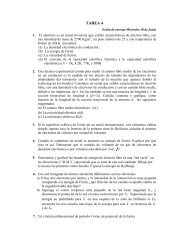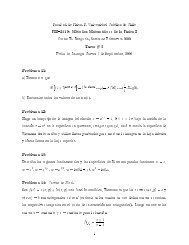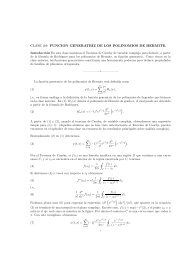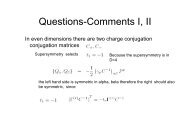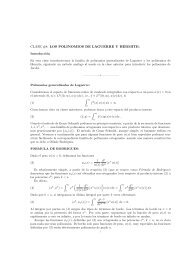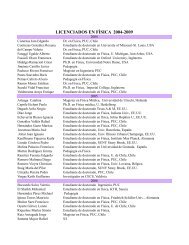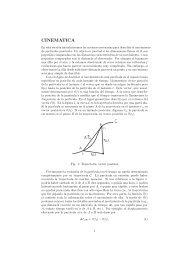Movimiento oscilatorios: libre, amortiguado, forzado.
Movimiento oscilatorios: libre, amortiguado, forzado.
Movimiento oscilatorios: libre, amortiguado, forzado.
You also want an ePaper? Increase the reach of your titles
YUMPU automatically turns print PDFs into web optimized ePapers that Google loves.
Oscilador armónico <strong>forzado</strong><br />
Segunda ley de Newton:<br />
F(t) = Fext cos(ωt)<br />
m x¨ = −kx − b x˙ + Fext cos (ωt), x¨ + b<br />
m x˙ + ω 0 2 x =<br />
Fext<br />
m cos(ωt)<br />
Solución particular de la ecuación anterior:<br />
y¨+ b<br />
m y˙ + ω 0 2 y = Fext<br />
m eiωt<br />
x = Ae iωt<br />
<br />
A −ω2 + b<br />
m iω + ω0 2<br />
<br />
eiωt = Fext<br />
m eiωt<br />
A =<br />
−ω2 + b<br />
<br />
Fext/m<br />
−ω 2 + b<br />
m iω + ω 0 2<br />
m iω + ω 0 2 = Re iφ<br />
R = (ω 0 2 − ω 2 ) 2 +<br />
A = Fext<br />
mR eiφ<br />
tan φ =<br />
bω<br />
m<br />
2<br />
bω<br />
m<br />
ω 0 2 − ω 2<br />
x(t)=Re(y(t))= Fext<br />
cos(ωt + φ)<br />
mR<br />
14






